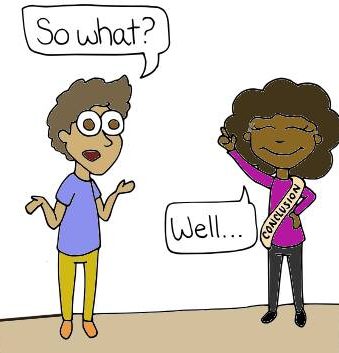77 Writing Conclusions
Studies have shown that the human brain is more likely to remember items at the beginning and end of lists, presentations, and other texts. Recollection of the last thing a person reads or hears is called the recency effect– they’re remembering the most recent information they’ve encountered. This is why your conclusion is so important. It’s your final chance to make an impression on your readers.
Conclusions have two jobs:
- Leave readers with something to think about.
- Clarify why your topic matters to them and the larger community. Some people refer to a conclusion as the so what? section of a text, because it helps readers understand the significance of your subject. See Figure 7.7.

Figure 7.7: The conclusion as the “so what?” section
What techniques can keep readers thinking about the topic at the end of a piece of writing? Some of the same methods that work for the introduction also work for the conclusion, but the formula is a little different:
You’re trying to end your piece, so don’t start making new claims or sharing new research. Instead, try to help readers see how they relate to your subject matter. Sometimes this means suggesting that the reader do something specific: a call to action. You could also end by raising questions related to your topic or by making suggestions for how this topic may develop in the future. Leaving readers with interesting ideas to think about is the key to a successful conclusion. See Film Clip 7.2 about writing conclusions.
Film Clip 7.2: Writing conclusions [1:03]
See Table 7.6 for methods and examples for concluding your writing and giving your readers a sense of closure or an idea of what you would like them to think about or do next.
Table 7.6: Methods and examples for conclusions
| Method | Example |
|---|---|
|
Make a call to action: prompt readers to do something. |
Nurses are uniquely positioned to advocating for better public policy to limit and restrict the consumption of sugar. |
|
Ask a rhetorical question: a question asked for mere effect. A rhetorical question is meant to make people think, but not necessarily come to an answer. Often, the answer to rhetorical questions is clear right away, but the deeper significance needs to be pondered. |
Have you considered the impact of sugar consumption on your health or the clients you care for? |
Student Tip
Optimizing Your Conclusion
Avoid introducing new ideas in the conclusion. But don’t simply copy and paste your thesis from earlier in the text. You’ve likely had a whole conversation in the text since the reader first encountered that thesis. Simply repeating it, or even replacing a few key words with synonyms, doesn’t acknowledge that bigger conversation. Instead, try pointing the reader back to the main idea in a new way.
Attribution statement
Content from this page was remixed with our own original content and adapted, with editorial and organizational changes, from:
The Word on College Reading and Writing by Carol Burnell, Jaime Wood, Monique Babin, Susan Pesznecker, and Nicole Rosevear, licensed under a Creative Commons Attribution-NonCommercial 4.0 International License, except where otherwise noted.Download for free at: https://openoregon.pressbooks.pub/wrd/

